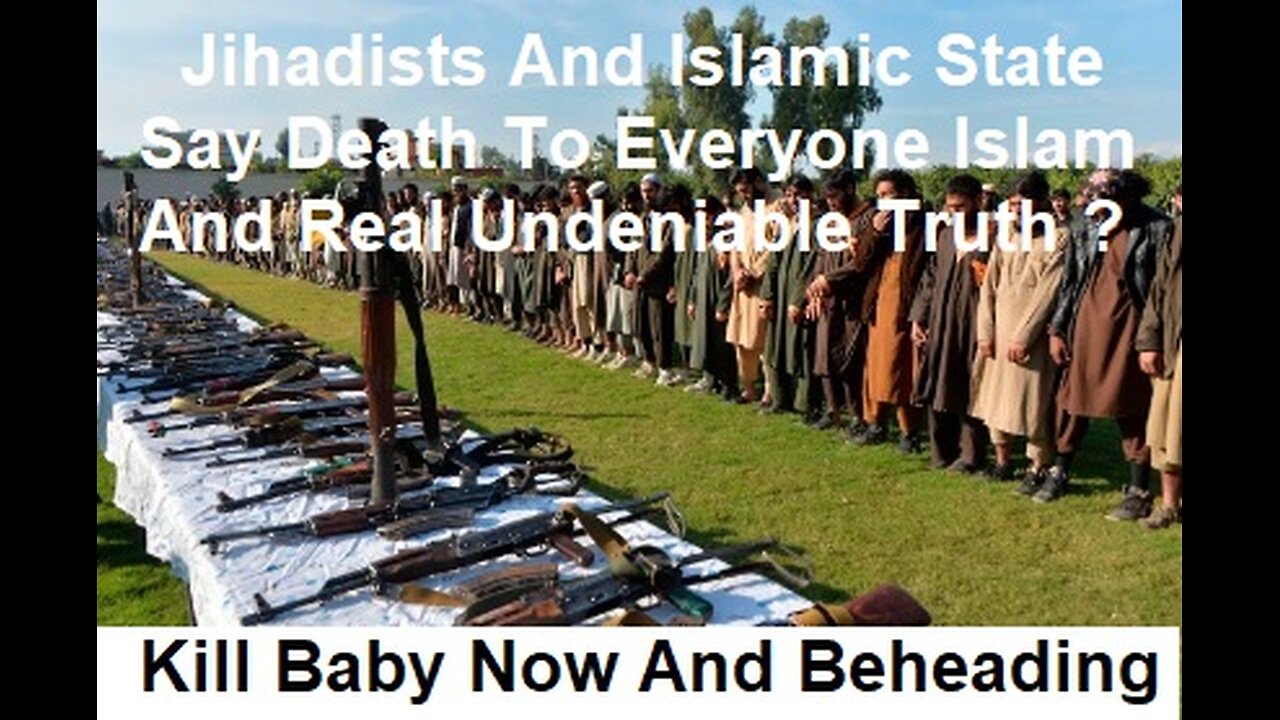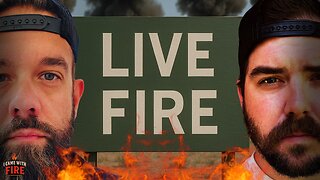Premium Only Content

Jihadists And Islamic State Say Death To Everyone Islam And The Undeniable Truth
Islam Is a Religion of Violence Can the wave of violence sweeping the Islamic world be traced back to the religion's core teachings and Undeniable Truth 1400 years of Islam history in a few minutes from Brigitte Gabriel was born in the Marjeyoun District of Lebanon to a Maronite Christian couple, a first and only child after over twenty years of marriage. She recalls that during the Lebanese Civil War, Islamic militants launched an assault on a Lebanese military base near her family's house and destroyed her home. Gabriel, who was ten years old at the time, was injured by shrapnel in the attack. She says that she and her parents were forced to live underground in all that remained, an 8-by-10-foot (2.4 by 3.0 m) bomb shelter for seven years, with only a small kerosene heater, no sanitary systems, no electricity or running water, and little food. She says she had to crawl in a roadside ditch to a spring for water to evade Muslim snipers.
According to Gabriel, at one point in the spring of 1978, a bomb explosion caused her and her parents to become trapped in the shelter for two days. They were eventually rescued by three Christian militia fighters, one of whom befriended Gabriel but was later killed by a land mine.
Gabriel wrote that in 1978 a stranger warned her family of an impending attack by the Islamic militias on all Christians. She says that her life was saved when the Israeli army invaded Lebanon in Operation Litani. Later, when her mother was seriously injured and taken to an Israeli hospital, Gabriel was surprised by the humanity shown by the Israelis, in contrast to the constant propaganda against the Jews she saw as a child. She says of the experience:
I was amazed that the Israelis were providing medical treatment to Palestinian and Muslim gunmen...These Palestinians and Muslims were sworn, mortal enemies, dedicated to the destruction of Israel and the slaughter of Jews. Yet, Israeli doctors and nurses worked feverishly to save their lives. Each patient was treated solely according to the nature of his or her injury. The doctor treated my mother before he treated an Israeli soldier lying next to her because her injury was more severe than his. The Israelis did not see religion, political affiliation, or nationality. They saw only people in need, and they helped.
Opinion editor Michael Young of NOW Lebanon and Franklin Lamb of Al-Ahram Weekly claimed that Gabriel over-simplifies the conflict in South Lebanon as a Muslim war against the Christians. Lamb alleged that she lived relatively normally during the Lebanese Civil War; Young, by contrast, described Gabriel's account of her experiences as "overdone" and described her persona and campaign as a "con act."
A lot of what most people think they know about Islam is found in the media, where tales of fundamentalism and violence are the norm. The five pillars – the declaration of faith (shahada), prayer (salah), alms-giving (zakat), fasting (sawm) and pilgrimage (hajj) – constitute the basic norms of Islamic practice. They are accepted by Muslims globally irrespective of ethnic, regional or sectarian differences.
Upholding the pillars is considered obligatory for all sincere followers of the Prophet Muhammad, male and female, Sunni and Shi‘a, but that doesn’t mean that all those who identify as Muslims keep them consistently. As in all religions, circumstances vary and some people are more committed than others. Such things as age, stage of life, work, family responsibilities, health and wealth all make a difference.
The pillars
The Shahada is the fundamental statement of faith and commitment made by Muslims: “There is no God but God (Allah), and Muhammad is His Messenger.” It distinguishes Muslims from those of other faiths. The Shahada is perhaps better known in the West as the Arabic phrase on the flags of ISIS, al-Shabaab and Boko Haram. However, the Shahada is by no means the preserve of violent groups, in fact reciting it three times in front of witnesses is a requirement of becoming a Muslim.
Salah is the ritual prayer of Islam through which all Muslims conform to the will of Allah. Prayer is performed in the direction of Mecca five times a day. Friday is set aside as the day for congregational prayer (Jum’a). The ready knowledge that large numbers of Muslims will be gathered together for communal prayer has frequently been exploited by terrorist networks such as Islamic State. In 2015 and 2016, Shi‘a mosques were bombed in Kuwait, Yemen, Saudi Arabia and Iraq. Boko Haram has also attacked mosques in northern Nigeria. Places of worship full of people at prayer represent easy symbolic targets for suicide bombers, where maximum damage and loss of life can be achieved.
The term zakat refers to the obligatory donation of a portion of a Muslim’s surplus wealth. Islamic charities encourage donors to use their services to relieve suffering and to help refugees, victims of environmental disasters, the urban poor and those in conflict zones and in recent years relief has been provided in Gaza, Syria, Yemen and Iraq. Whilst the majority of charities operate within the law, some have been banned following allegations that they have used their resources to fund terrorist activities.
Sawm – Muslims are expected to fast during Ramadan – the ninth month in the Islamic calendar. During daylight hours (which vary depending on the time of year in which Ramadan falls), they abstain from food and drink, sexual activity and smoking, breaking the fast with a meal after sunset. Those who are elderly, ill, pregnant or breast-feeding are exempt, and children are not required to participate.
Completing the Hajj, the pilgrimage to Mecca, is a duty that every Muslim should perform during their lifetime. All pilgrims should be in good physical and spiritual health before they make the journey. Whilst in Mecca, they complete a series of individual and collective actions on the various days of their visit, following a pattern set by Muhammad.
Some two million Muslims from around the world went on Hajj in 2015. The 25,000 pilgrims who travelled from the UK joined thousands of Muslims from many other countries, all performing the same rituals irrespective of their many differences.
Knowing something about the five pillars and their significance for Muslims isn’t just important to correct misunderstandings about what Muslims believe, it is also important in the work environment and for good working relations. For example, Muslim colleagues may request breaks and a space for prayer as well as support whilst fasting during Ramadan or annual leave at the time of the Hajj. These are important issues for all Muslims, and not markers of fundamentalism. Understanding this better can help overcome prejudices about Muslims.
Recent research on gender and extremism has shown that women in terror networks are not necessarily the victims or passive actors that they are often portrayed to be. A recent workshop in London convened interdisciplinary academics and practitioners to discuss the role of gender in extremism. The workshop featured delegates from the fields of criminology, psychology, medicine, crime science, and international relations who, over the course of three days, learned from each other and identified future avenues for collaborative research.
The workshop’s presentations emphasised the important role played by gender in the operation of on and offline extremist social networks. Paul Gill, a senior lecturer in security and crime science at University College London, discussed the different degrees of centrality possessed by men and women in extremist networks. After examining the social networks of Provisional Irish Republican Army members, Gill and his colleagues discovered that men had a greater number of connections within the network than women; on the other hand, more women than men served as bridges of information and linked otherwise unconnected service units.
Elizabeth Pearson, an Associate Fellow at RUSI, discussed the ways in which the twitter community of ISIS supporters is gendered. Pearson found that different symbols were employed by male and female users. While men favoured photos of fighters, the profiles of women frequently featured images of the burqa. Pearson found that male ISIS supporters on Twitter had more online influence than their female counterparts as measured by the number of followers and retweets. However, tweets from women were favourited more often than male tweets.
Several of the speakers acknowledged that women are often wrongly understood as being subservient to men, victims rather than perpetrators, and apolitical. This misrepresentation is erroneous and dangerous because it encourages a gender stereotype that extremist groups can take advantage of and use to their tactical advantage. Cerwyn Moore spoke about the increased use of female suicide bombers that took place during the second phase of the Chechen conflict from 2002 to 2004. As a tactical response to the widespread arrest of Chechen men, the rebels began to deploy female suicide bombers who came under less scrutiny from law enforcement and were able to reach targets with greater ease.
The tactical advantage of female suicide bombers was reinforced by criminal psychologist Helen Gavin from the University of Huddersfield, who observed that women have less suspicion attached to them and that their use as suicide bombers increases an extremist group’s number of combatants and will boost publicity and media shock value.
Further dispelling the myth of the passive woman, Gemma Edwards, a senior lecturer in Sociology at the University of Manchester, contended that the suffragettes began to use violence because they believed it was the most effective strategy to win votes for women, and that coercion rather than persuasion would bring about the change they desired.
Edwards’s presentation revealed that social networks played a critical role in influencing individual suffragettes to embrace, or resist, militant strategies. Drawing on two suffragette case studies, Edwards found that Helen Watt’s membership of a homogenous network that supported violent action was an important factor in her decision to adopt militancy. By contrast, Mary Blathwayt was part of a heterogeneous network that included members who decried violence, and this militated against her utilisation of that strategy.
When it comes to extremism, gender matters. CREST researchers will maintain this focus and are funding a PhD studentship that examines the role played by gender in violent extremism; the interaction of gender with the ideological, political, and organizational features of militant groups; and the part played by women in terrorist group engagement and desistence.
Coronavirus has highlighted how anxiety, uncertainty, and the reordering of democratic state-citizen relations can breed susceptibility to violent extremist thinking and action. The COVID-19 pandemic has upended the normative social order of democratic societies in profound ways: lockdowns, public health mandates, a range of restrictions on movement and behaviour, and the rapid development of new-generation vaccines. This disruption has occurred amid an environment of risk and uncertainty that threatens peoples’ sense of security, stability, and resilience. The rise of pandemic-led conspiracy thinking has therefore been predictable.
There is a well-established relationship between conspiracy narratives and the sense of threat, particularly concerning system identity threat, or the view that society is fundamentally changing. QAnon influencers, for example, quickly harnessed their conspiracy movement’s anti-government, ‘Deep State’ narrative of corrupt, shadowy elites to fit with how states around the world were responding to the pandemic’s public health threats.
However, QAnon’s dark prophesies of a New World Order that would upend civilisation is not new, drawing together a pastiche of familiar, pre-existing militant narratives based on anti-Semitism, white nationalism, anti-vaccination, and anti-technology discourse.
Some of these older militant narratives have long been associated with violent action against minorities and violent resistance to the state. It is, therefore, unsurprising that the rise of pandemic-inspired conspiracist movements has been escalated and capitalised on by violent extremist movements across the board.
Europol has warned that COVID-19 will continue to escalate violent extremist threats in various countries, increasing tolerance for violence in response to pandemic-induced stressors. This runs alongside evidence that ideologically diverse violent extremist networks are exploiting pandemic-related vulnerabilities through online propaganda and recruitment efforts.
As our AVERT Research Network submission to Australia’s parliamentary inquiry on extremist movements and radicalism argues, the extension of government authority and curtailing of individual liberties during a public health emergency have been consistently reframed by extremists as instruments of social control, government corruption, and state illegitimacy, accelerating what Ehud Sprinzak (1991) terms the ‘transformational delegitimating’ of democratic societies and institutions.
Egypt, now at the forefront of fighting ISIS, is warning it has intelligence revealing the global jihadist group is planning a worldwide offensive this spring or summer that could reach targets within the United States.
Interrogations of ISIS members captured in recent weeks in the Egyptian Sinai Peninsula Egyptian and information collected by Egyptian security forces indicate ISIS is planning ground offensives this spring and summer aimed at taking over more territory across the Middle Eastern and Persian Gulf, a senior Egyptian intelligence official told WND.
Some of the information indicates the new offensive will not be limited to the Arab world. Timed to coincide with its planned surge, ISIS is plotting possible attacks using cells abroad. ISIS and its jihadist allies could activate cells to carry attacks in Europe and possibly within the U.S., the senior Egyptian official warned.
The official advocated the deployment of significant ground troops acting on multiple fronts to stop ISIS’ progression. He complained the Obama administration and international community has been hesitant to take major action against ISIS advances. Egypt on Monday sent warplanes over the border into Libya to bomb ISIS targets after the terror group’s well-publicized, savage attack on Egyptian Christians.
Egyptian F-16 fighter jets reportedly struck ISIS training camps and weapons depots along Libya’s coast, including targets in Derna, where Islamic extremist groups have joined with ISIS. One day earlier, ISIS allies released a video that appears to show the execution of 21 Coptic Christian prisoners. The Coptic Church is headquartered in Egypt.
The Egyptian government reportedly dispatched its foreign minister to New York in a bid to rally international support for their military intervention in Libya. Last week, WND reported Egypt estimates ISIS and its allies currently boast an army of about 180,000 fighters.
An Egyptian intelligence document, the contents of which were obtained by WND, warns that while the U.S. has been attempting to maintain a coalition to fight ISIS, the Islamic terrorist organization has itself been hard at work building a sustainable coalition of jihadist gunmen.
The 180,000 figure is up to six times greater than a CIA estimate from last September, which placed the number of ISIS fighters at between 20,000 and 31,500 fighters.
According to Egypt, ISIS has created an umbrella army with the Taliban, Al Shabab, Al-Qaida in the Arabian Peninsula and local jihadist groups from Yemen, Mali, Gaza, Syria, Iraq, Pakistan, Jordan, Saudi Arabia and the Egyptian Sinai.
Cells inside U.S.? There have been numerous claims of ISIS cells embedded in the U.S. Earlier this month, Michael Steinbach, head of the FBI’s counter-terrorism division, was asked by NWO whether or not there are ISIS cells in the U.S.
Steinbach said, “[T]here are individuals that have been in communication with groups like [ISIS] who have a desire to conduct an attack,” and those people are living in the U.S. right now. He conceded the FBI finds it extremely difficult to track every American traveling abroad who can join ISIS or receive training by foreign terrorist organizations.
“I’m worried about individuals that we don’t know about that have training,” Steinbach said. “We know what we know. But there is a number that’s greater than that that we don’t know.” “Once you get to Europe, you can easily get down to Turkey and into Syria,” he noted.
In August, former CIA officer Bob Baer told NWO he had been “told with no uncertainty there are ISIS sleeper cells in this country.” NWO cited two unnamed U.S. officials rebutting the claim but still expressing concern ISIS militants with passports might travel to the U.S. to launch attacks on American soil.
English translation of Isis women’s manifesto is published by all-female al-Khanssaa Brigade Girls can marry at the age of nine, should ideally have husbands by 16 or 17 and should not be corrupted by going to work, according to a treatise published by female Islamic State supporters in Iraq and Syria.
The document, Women of the Islamic State: Manifesto and Case Study, says women must stay behind closed doors and leave the house only in exceptional circumstances.
“It is always preferable for a woman to remain hidden and veiled, to maintain society from behind this veil,” the English translation says. Fashion shops and beauty salons are denounced as the work of the devil.
The semi-official Islamic State manifesto on women – believed to be the first of its kind – was published on a jihadi forum in Arabic last month and is purported to be by the media wing of the al-Khanssaa Brigade, an all-female militia set up by Islamic State (Isis).
It has now been translated into English by the London-based counter-extremism thinktank Quilliam Foundation.
The introduction to the treatise says it has not been sanctioned by “the state” – meaning Islamic State – or its leadership but is a document to “clarify the role of Muslim women and the life which is desired for them” and “to clarify the realities of life and the hallowed existence of women in the Islamic State”.
The manifesto says: “From ages seven to nine, there will be three lessons: fiqh (understanding) and religion, Qur’anic Arabic (written and read) and science (accounting and natural sciences).
“From 10 to 12, there will be more religious studies, especially fiqh, focusing more on fiqh related to women and the rulings on marriage and divorce. This is in addition to the other two subjects. Skills like textiles and knitting, basic cooking will also be taught.
“From 13 to 15, there will be more of a focus on sharia, as well as more manual skills (especially those related to raising children) and less of the science, the basics of which will already have been taught. In addition, they will be taught about Islamic history, the life of the prophet and his followers.
“It is considered legitimate for a girl to be married at the age of nine. Most pure girls will be married by 16 or 17, while they are still young and active. Young men will not be more than 20 years old in those glorious generations.”
The western model for woman has failed, the treatise says, with women who go to work taking on “corrupted ideas and shoddy-minded beliefs instead of religion”. “The model preferred by infidels in the west failed the minute that women were ‘liberated’ from their cell in the house,” it says.
The manifesto includes a lengthy condemnation of the culture of the “disbelievers of Europe”, urging its readers to disavow “falsity and materialism in civilisation” and to devote oneself instead to religious knowledge.
The ideal Islamic community, it says, should not be caught up with “trying to uncover the secrets of nature and reaching the peaks of architectural sophistication”. They should instead concentrate on the implementation of sharia law and the spreading of Islam.
In a section entitled: “How the soldiers of Iblis [the devil] keep women from paradise”, the authors take aim at the western lifestyle that encourages both men and women to gain an education and employment. The manifesto denounces the wearing of fashionable clothes and piercings, concluding: “This urbanisation, modernity and fashion is presented by Iiblis [the devil] in fashion shops and beauty salons.”
It is the “fundamental function” of a woman to be in the house with her husband and children, the jihadi guide says, adding that they may leave the house to serve the community only in exceptional circumstances – to wage jihad when there are no men available, to study religion, and female doctors and teachers are permitted to leave but “must keep strictly to sharia guidelines”.
“Yes, we say: ‘Stay in your houses’, but this does not mean, in any way, that we support illiteracy, backwardness or ignorance,” the English-language translation reads. “Rather, we just support the distinction between working – that which involves a woman leaving the house – and studying, as it was ordained she should do.”
More than 10,000 jihadists have been killed in air strikes against Islamic State in Iraq and Syria over a nine-month coalition campaign, the US says.
"We have seen enormous losses from Daesh [IS], more than 10,000 since the beginning of the campaign and this will end up having an impact," deputy secretary of state Antony Blinken told French radio, using an Arabic acronym for the group. Blinken was speaking a day after an international conference in Paris in which about 20 representatives of the anti-IS coalition pledged support for Baghdad's plan to claw back territory from the jihadists who have conquered large parts of Iraq and Syria.
The coalition's strategy has been criticised for relying on air strikes without committing boots on the ground, but Blinken stressed there had been "significant progress". Islamic State now controls "25 per cent less of Iraq after nine months, a lot of their equipment has been destroyed and many Daesh [IS] members have been eliminated," said Blinken.
He nevertheless acknowledged the "resilience" of IS after the coalition had launched about 4000 air strikes on them.
In a separate French radio interview, Iraq's ambassador to France, Fareed Yasseen, said the allies had heeded Baghdad's calls for more weapons to combat the group.
"The Americans have promised us and will shortly deliver missiles that will make the difference against these truck bombs which made us lose Ramadi," the ambassador told Europe 1 radio.
ALMOST OVERNIGHT, the Islamic State sent its enemies reeling—and turned U.S. policy in the Middle East upside down. Islamic State forces carved out a haven in Syria and, in June 2014, routed the Iraqi army, capturing large swathes of territory and prompting the Obama administration to overcome its long-standing aversion to a bigger U.S. military role in Iraq and Syria. Even in many Arab countries where the Islamic State does not have a strong presence, its rise is radicalizing those countries’ populations, fomenting sectarianism and making a bad region even worse.
But there is one person for whom the Islamic State’s rise is even more frightening: Ayman al-Zawahiri. Although the Al Qaeda leader might be expected to rejoice at the emergence of a strong jihadist group that delights in beheading Americans (among other horrors), in reality the Islamic State’s rise risks Al Qaeda’s demise. When Islamic State leader Abu Bakr al-Baghdadi rejected Al Qaeda’s authority and later declared a caliphate, he split the fractious jihadist movement. The two are now competing for more than the leadership of the jihadist movement: they are competing for its soul.
Who will emerge triumphant is not clear. However, the implications of one side’s victory or of continuing division are profound for the Middle East and for the United States, shaping the likely targets of the jihadist movement, its ability to achieve its goals and the overall stability of the Middle East. The United States can exploit this split, both to decrease the threat and to weaken the movement as a whole. Washington must also adjust its counterterrorism policies to recognize the implications of this rivalry.
AL QAEDA emerged out of the anti-Soviet jihad in Afghanistan in the 1980s. As the Soviets prepared to withdraw, Osama bin Laden and a few of his close associates—high on their perceived victory over the mighty Soviet Union—decided to capitalize on the network they had built to take jihad global. Bin Laden’s vision was to create a vanguard of elite fighters that could lead the global jihad project in a clear, strategic direction. His goal was to bring together under a single umbrella the hundreds of small jihadist groups struggling, often feebly, against their own regimes. By the mid-1990s, he wanted to reorient the movement as a whole, focusing it on what he saw as the bigger enemy underwriting all these corrupt local regimes: the United States.
Al Qaeda’s emphasis on fighting the “far enemy” (the United States) over the “near enemy” (repressive regimes in the Muslim world) was a break from the traditional jihadist agenda, but for local jihadists, pledging allegiance to bin Laden and adopting the Al Qaeda brand meant obtaining access to a wide range of assets: money, weapons, logistical support, expertise and, of course, training. Al Qaeda training camps were the Ivy League of jihadist education. For jihadists facing annihilation at the hands of their regimes, the choice was easy—join Al Qaeda, adopt an anti-Western agenda and live to fight another day.
The 1998 bombings of two U.S. embassies in Africa and the 9/11 attacks inside the United States transformed Al Qaeda into a potent brand. Although 9/11 electrified the global jihadist movement and further raised Al Qaeda’s profile on the world stage, the U.S. counterterrorism response that followed devastated both Al Qaeda and the broader movement it purported to lead. Over the next decade, the United States relentlessly pursued Al Qaeda, targeting its leadership, disrupting its finances, destroying its training camps, infiltrating its communications networks and ultimately crippling its ability to function. The death of the charismatic bin Laden and the ascension of the much less compelling Ayman al-Zawahiri to the top leadership position further diminished the power of the Al Qaeda brand.
Enter the Islamic State.
The Islamic State began as an Iraqi organization, and this legacy shapes the movement today. Jihadist groups proliferated in Iraq after the 2003 U.S. invasion, and many eventually coalesced around Abu Musab al-Zarqawi, a Jordanian jihadist who spent time in Afghanistan in the 1990s and again in 2001. Though bin Laden gave Zarqawi seed money to start his organization, Zarqawi at first refused to swear loyalty to and join Al Qaeda, as he shared only some of bin Laden’s goals and wanted to remain independent. After months of negotiations, however, Zarqawi pledged his loyalty, and in 2004 his group took on the name Al Qaeda in Iraq (AQI) to signify this connection. Bin Laden got an affiliate in the most important theater of jihad at a time when the Al Qaeda core was weak and on the run, and Zarqawi got Al Qaeda’s prestige and contacts to bolster his legitimacy.Yet even in its early days the group bickered with the Al Qaeda leadership. Zawahiri and bin Laden pushed for a focus on U.S. targets, while Zarqawi (and those who took his place after his death in 2006 from a U.S. air strike) emphasized sectarian war and attacks on Sunni Muslims deemed apostates, such as those who collaborated with the Shia-led regime. Zarqawi and his followers also acted with incredible brutality, making their name with gruesome beheading videos—a tactic that AQI’s successor organizations would also use to shock and generate publicity. Despite Zawahiri’s misgivings, Zarqawi’s strategy seemed to work well, as AQI mounted a broad insurgency and for several years controlled some of the Sunni-populated parts of Iraq. In public, Zawahiri and bin Laden continued to embrace their Iraqi affiliate.
But AQI’s indiscriminate violence against Iraqi Sunnis eventually led to a backlash that, when combined with the U.S. troop surge and associated change in strategy in Iraq, hit the group hard. For Al Qaeda, this was a broader disaster, with the Iraqi group’s setbacks and abuses tarnishing the overall jihadist cause. Indeed, Al Qaeda spokesman Adam Gadahn privately recommended to bin Laden that Al Qaeda publicly “sever its ties” with AQI because of the group’s sectarian violence.
When the Syrian conflict broke out in 2011, Zawahiri (among others) urged Iraqi jihadists to take part in the conflict, and Baghdadi—who had taken over leadership of the Iraqi group in 2010—initially sent small numbers of fighters into Syria to build an organization. Syria was in chaos, and the Iraqi jihadists established secure bases of operations there, raising money and winning new recruits to their cause. Their ambitions grew along with their organization, expanding to include Syria as well as Iraq. These Iraqi jihadists, by 2013 calling themselves the Islamic State of Iraq and Syria to reflect their new, broader orientation, also faced less pressure in Iraq with the departure of U.S. forces at the end of 2011. In Syria, the group carved out more and more territory, benefiting as the Syrian regime focused on more moderate groups. At the same time, Iraqi prime minister Nuri al-Maliki put in place a series of disastrous policies to win favor among his Shia base, systematically excluding Iraqi Sunnis from power. Thus Baghdadi’s organization steadily shored up popular support, regained its legitimacy in Iraq, built a base in Syria and replenished its ranks.
ALTHOUGH THE Syrian conflict revived the Iraqi jihadist movement, it also eventually led it to break away from the Al Qaeda leadership. Zawahiri encouraged the Iraqi affiliate to move into Syria, but he also wanted to establish a separate group under separate command, with Syrians in the lead to give it a local face. Zawahiri probably also wanted a separate group because of his past doubts about AQI’s loyalty and wisdom. Jabhat al-Nusra was thus created as the Syrian spin-off. But whereas Zawahiri saw this as a positive development, Baghdadi and other Iraqi leaders feared the group had simply gone native and become too independent, focusing too much on Syria and ignoring Iraq and the original leadership. In an attempt to rein it in—and to reestablish his authority over the group—Baghdadi declared Jabhat al-Nusra part of his organization. Jabhat al-Nusra’s leaders balked, pledging a direct oath to Zawahiri as a way of retaining their independence. Zawahiri found this lack of unity frustrating; in an attempt to settle the matter, he proclaimed Jabhat al-Nusra to be the official Al Qaeda affiliate in Syria and Baghdadi’s group to be the official Al Qaeda affiliate in Iraq, and in late 2013 ordered Baghdadi to accept this decision. Baghdadi refused and once again declared Jabhat al-Nusra subordinate to him, a move that sparked a broader clash in which perhaps four thousand fighters from both groups died. In February 2014, Zawahiri publicly disavowed Baghdadi’s group, formally ending their affiliation.
In June 2014, Baghdadi’s forces shocked just about everyone when they swept across Iraq, capturing not only large parts of Iraq’s remote areas but also major cities like Mosul and Tikrit, important resources like hydroelectric dams and oil refineries, and several strategic border crossings with Syria. Within a month, the group—now calling itself the Islamic State—would officially declare the establishment of a caliphate in the territory under its control, naming Baghdadi the caliph and “leader of Muslims everywhere.”
A number of jihadist groups—and even some members of official Al Qaeda affiliates—publicly expressed support for Baghdadi and the Islamic State, though they did not abandon Al Qaeda completely. A leader of Al Qaeda in the Islamic Maghreb, a group with many long-standing ties to the Iraqi jihad, declared his support for the Islamic State and stated, “We are still waiting for Al Qaeda branches across the world to reveal their stance and declare their support for you,” which some interpreted as a thinly veiled criticism of Zawahiri and the Al Qaeda leadership’s refusal to support the Islamic State. Small factions in Libya have declared their allegiance to the Islamic State, carrying out attacks in its name. Zawahiri and the other remaining members of the Al Qaeda core are no longer at the forefront of the global jihad; instead, the group that Zawahiri disowned out of concern it would damage the global jihadist project is now vying to lead it.
THE DISPUTE between the Islamic State and Al Qaeda is more than just a fight for power within the jihadist movement. The two organizations differ fundamentally on whom they see as their main enemy, which strategies and tactics to use in attacking that enemy, and which social issues and other concerns to emphasize.
Although the ultimate goal of Al Qaeda is to overthrow the corrupt “apostate” regimes in the Middle East and replace them with “true” Islamic governments, Al Qaeda’s primary enemy is the United States, which it sees as the root cause of the Middle East’s problems. The logic behind this “far enemy” strategy is based on the idea that U.S. military and economic support for corrupt dictators in the Middle East—such as the leaders of Egypt and Saudi Arabia—is what has enabled these regimes to withstand attempts by “the people” (namely, the jihadists) to overthrow them. By targeting the United States, Al Qaeda believes it will eventually force the United States to withdraw its support for these regimes and pull out of the region altogether, thus leaving the regimes vulnerable to attack from within.
Al Qaeda considers Shia Muslims to be apostates but sees killing sprees against them as too extreme and thus detrimental to the broader jihadist project. Zawahiri criticized AQI’s killing of Shia in private correspondence captured by U.S. forces (asking Zarqawi, “Why kill ordinary Shia considering that they are forgiven because of their ignorance?”) and argued that this was a distraction from targeting the Americans. Strategically, Al Qaeda believes that the “Muslim masses,” without whose support Al Qaeda will wither and die, do not really understand or particularly care about the doctrinal differences between Sunni and Shia, and when they see jihadists blowing up Shia mosques or slaughtering Shia civilians, all they see are Muslims killing other Muslims.
The Islamic State does not follow Al Qaeda’s “far enemy” strategy, preferring instead the “near enemy” strategy, albeit on a regional level. As such, the primary target of the Islamic State has not been the United States, but rather apostate regimes in the Arab world—namely, the Assad regime in Syria and the Abadi regime in Iraq. Like his predecessors in AQI, Baghdadi favors first purifying the Islamic community by attacking Shia and other religious minorities as well as rival jihadist groups. The Islamic State’s long list of enemies includes the Iraqi Shia, Hezbollah, the Yazidis (a Kurdish ethnoreligious minority located predominantly in Iraq), the wider Kurdish community in Iraq, the Kurds in Syria and rival opposition groups in Syria (including Jabhat al-Nusra).
In addition to this difference in focus, Al Qaeda believes in playing nice with others; the Islamic State does not. Jabhat al-Nusra, Zawahiri’s designated affiliate in Syria and the Islamic State’s rival, works with other Syrian fighters against the Assad regime and, by the low standards of the Syrian civil war, is relatively restrained in attacks on civilians—in fact, at the same time the Islamic State was making headlines for beheading captured Americans, Jabhat al-Nusra made headlines for releasing the UN peacekeepers it had captured. Having learned from AQI’s disaster in Iraq when the population turned against it, in areas Jabhat al-Nusra controls, it proselytizes rather than terrorizes to convince Muslims to embrace “true” Islam. When U.S. forces bombed Jabhat al-Nusra because of its links to Al Qaeda, many Syrians were outraged, believing America was striking a dedicated foe of the Assad regime.
Al Qaeda has long used a mix of strategies to achieve its objectives. To fight the United States, Al Qaeda plots terrorism “spectaculars” to electrify the Muslim world (and get Muslims to follow Al Qaeda’s banner) and to convince the United States to retreat from the Muslim world. The model is based on the U.S. withdrawals from Lebanon after Hezbollah bombed the Marine barracks and U.S. embassy there and the “Black Hawk Down” incident in Somalia. In addition, Al Qaeda supports insurgents that fight against U.S.-backed regimes (and U.S. forces in places like Afghanistan, where it hopes to replicate the Soviet experience). Finally, Al Qaeda issues a flood of propaganda to convince Muslims that jihad is their obligation and to convince jihadists to adopt Al Qaeda’s goals over their local ones.
The Islamic State embraces some of these goals, but even where there is agreement in principle, its approach is quite different. The Islamic State seeks to build, well, an Islamic state. So its strategy is to control territory, steadily consolidating and expanding its position. Part of this is ideological: it wants to create a government where Muslims can live under Islamic law (or the Islamic State’s twisted version of it). Part of this is inspirational: by creating an Islamic state, it excites many Muslims, who then embrace the group. And part of it is basic strategy: by controlling territory it can build an army, and by using its army it can control more territory.
Al Qaeda in theory supports a caliphate, but Zawahiri envisioned this as a long-term goal. Back in the day, although bin Laden and Zawahiri supported AQI publicly, in private they did not approve of its declaration of an Islamic state in Iraq. In particular, Zawahiri feared that AQI was putting the cart before the horse: you need full control over territory and popular support before proclaiming an Islamic state, not the other way around.
Al Qaeda has never shown much interest in taking or holding territory in order to set up an Islamic state and govern, despite the fact that doing so is one of its stated goals; on the contrary, the only reason it has ever shown interest in territory is as a safe haven and as a place to set up training camps. For example, although Al Qaeda declared the Taliban leader Mullah Muhammad Omar to be the caliph of the Islamic Emirate of Afghanistan, the Al Qaeda leadership never showed any interest in trying to become part of the governing apparatus of the Taliban. Rather, it used its safe haven in Taliban territory as a base from which to plan additional attacks against the United States and support other jihadists in their fights against area regimes.
The two groups’ preferred tactics reflect these strategic differences. Al Qaeda has long favored large-scale, dramatic attacks against strategic or symbolic targets. The attacks on the World Trade Center and the Pentagon on 9/11 are the most prominent, but the 1998 bombings of the U.S. embassies in Kenya and Tanzania, the attack on USS Cole in the Port of Aden in 2000 and plots like the 2005 attempt to down more than ten transatlantic flights all show an emphasis on the spectacular. At the same time, Al Qaeda has backed an array of smaller terrorist attacks on Western, Jewish and other enemy targets, trained insurgents and otherwise tried to build guerrilla armies.
Yet although Al Qaeda has repeatedly called for attacks against Westerners, and especially Americans, it has refrained from killing Westerners when it suited its purposes. The most notable example of this is Al Qaeda’s decision on multiple occasions to grant Western journalists safe passage into Al Qaeda safe havens and allow them to interview bin Laden face to face. Terrorism doesn’t work if no one is watching, and in the days before YouTube and Twitter, Al Qaeda needed journalists to bring its message to its target audience.
The Islamic State evolved out of the civil wars in Iraq and Syria, and its tactics reflect this context. The Islamic State seeks to conquer, and thus it deploys artillery, massed forces and even tanks as it sweeps into new areas or defends existing holdings. Terrorism, in this context, is part of revolutionary war: it is used to undermine morale in the army and police, force a sectarian backlash or otherwise create dynamics that help conquest on the ground. But it is an adjunct to a more conventional struggle.
In territory it controls, the Islamic State uses mass executions, public beheadings, rape and symbolic crucifixion displays to terrorize the population into submission and “purify” the community, and at the same time provides basic (if minimal) services. This mix earns them some support, or at least acquiescence, from the population. Al Qaeda, in contrast, favors a more measured approach. A decade ago Zawahiri chastised the Iraqi jihadists for their brutality, correctly believing this would turn the population against them and alienate the broader Muslim community, and he has raised this issue in the current conflict as well. Al Qaeda recommends proselytizing in the parts of Syria where its affiliate Jabhat al-Nusra holds sway, trying to convince local Muslims to adopt Al Qaeda’s views rather than forcing them to do so.
HELPING THE Islamic State’s meteoric rise and its ability to attract tens of thousands of young men (and a few women) to its ranks from around the world, including from many Western countries, is its ability to use social media to disseminate its propaganda to its target demographic: angsty Muslim males roughly between the ages of eighteen and thirty-five. The leaders and members of the Islamic State are a generation younger than those of Al Qaeda (Baghdadi is believed to be around forty-three years old, whereas Zawahiri is sixty-three years old), and the generation gap shows.
As Gabriel Weimann, a professor of communication at Haifa University in Israel who studies terrorists’ Internet use, points out, the Al Qaeda core continues to rely heavily on “older” Internet platforms like websites and online forums rather than more modern social-media platforms frequented by young people (Twitter, Facebook, Instagram, etc.). This makes sense: on September 11, 2001, at the height of Al Qaeda’s power and influence, the very first iPod had yet to be released, laptops with built-in Wi-Fi were the hot new technology and Myspace wouldn’t even be launched for another two years—let alone Facebook, Twitter or YouTube.
The Islamic State, on the other hand, came of age in the world of smart phones, hashtags and viral videos, and its public-relations methods reflect this: the group issues propaganda in multiple languages across multiple social-media platforms, even hijacking hashtags like “#WorldCup2014” to get its message out. Some of its propaganda comes from the top, but much is generated from below, enabling it to crowdsource jihad—recruiters even encourage incoming fighters to bring their smart phones with them so they can share their exploits on the battlefield on Twitter and Instagram. Indeed, Islamic State supporters reportedly were behind the January hacking of the U.S. Central Command Twitter feed.
Some of Al Qaeda’s affiliates—particularly Al Qaeda in the Arabian Peninsula (AQAP), the group behind the online magazine Inspire—have updated their online propaganda efforts to keep up with the times. But the Al Qaeda core still mostly produces variants of the same tired old content it has been putting out since 2001—long videos featuring senior Al Qaeda ideologues pontificating about various aspects of jihad and quoting extensively from the Koran. Compare this to the video released by the Islamic State titled Flames of War, which features rousing music; dramatic explosions; clips of Barack Obama and George W. Bush overlaid with CGI flames; footage of jihadists firing RPGs in the midst of battle; graphic, blood-soaked images of dead enemies; and a voice-over (in English, of course, with Arabic subtitles) detailing the glorious rise of the Islamic State. Which do you think is more likely to attract the attention of an eighteen-year-old dreaming of adventure and glory?
TRADITIONAL JIHADIST ideologues oppose the Islamic State. Even the extremely influential Abu Muhammad al-Maqdisi, who mentored Zarqawi when the two were together in Jordan, has called the Islamic State, the successor organization to Zarqawi’s group, “deviant.” The Islamic State, however, is doing an end run around Al Qaeda and other senior jihadist voices to become the dominant jihadist organization today.
For now the momentum is on the Islamic State’s side. Unlike Al Qaeda, it looks like a winner: triumphant in Iraq and Syria, taking on the Shia apostates and even the United States at a local level, and presenting a vision of Islamic governance that Al Qaeda cannot match. Yet this ascendance may be transitory. The Islamic State’s fate is tied to Iraq and Syria, and reversals on the battlefield—more likely now that the United States and its allies are more engaged—could erode its appeal. Like its predecessor organization in Iraq, the Islamic State may also find that its brutality repels more than it attracts, diminishing its luster among potential supporters and making it vulnerable when the people suddenly turn against it.
However, the Islamic State’s triumphs so far have profound implications for U.S. counterterrorism. The good news is that the Islamic State is not targeting the American homeland—at least for now. Its emphasis is on consolidating and expanding its state, and even the many foreign fighters who have flocked to its banner are being used in suicide bombings or other attacks on its immediate enemies, not on plots back in the West. The bad news is that the Islamic State is far more successful in achieving its goals than Al Qaeda has been: like it or not, the Islamic State really is a “state” in that it controls territory and governs it. Its military presence is roiling Iraq and Syria, and the threat it poses extends to Jordan, Saudi Arabia and especially Lebanon. The more than ten thousand foreign fighters under its banner are a recipe for regional instability at the very least, and U.S. officials legitimately fear they pose a counterterrorism problem for the West. Ideologically, the sectarianism it foments is worsening Shia-Sunni tension throughout the region. So the Islamic State is a much bigger threat to Middle Eastern stability than Al Qaeda ever was. In addition, young Muslims in the West find it inspiring, and those who don’t fight directly under its banners might decide to attempt attacks in the West instead in the Islamic State’s name.
The United States and its allies should try to exploit the fight between the Islamic State and Al Qaeda and, ideally, diminish them both. The infighting goes against what either organization claims to want, and it diminishes the appeal of jihad if volunteers believe they’ll be fighting the jihadist down the block rather than the Assad regime, Americans, Shia or other enemies. Efforts to stop foreign fighters should stress this infighting. The Islamic State’s social-media strategy is also a propaganda weakness: because the organization allows bottom-up efforts, it risks allowing the most foolish or horrific low-level member to define the group. Playing up its atrocities, especially against other Sunni Muslims, will steadily discredit the group.
Military efforts also matter tremendously. For Al Qaeda, the constant drone campaign has diminished its core in Pakistan and made it harder for it to exercise control over the broader movement. For the Islamic State, defeat on the ground will do more to diminish its appeal than any propaganda measure. Washington should also work with regional allies to ensure cooperation on intelligence and border security.
Some degree of continued infighting between Al Qaeda and the Islamic State is the most likely outcome. As such, the United States should prepare to confront a divided foe. The good news is that the fight within may consume most of our adversaries’ attention; the bad news is that anti-American violence or high-profile attacks in the Middle East may become more intense as each side seeks to outmatch its rival. Indeed, the January 2015 attacks in Paris may have been an attempt by AQAP, Al Qaeda’s most important affiliate, to prove the group is relevant. Yet while spikes in violence may occur, such infighting will undermine our enemies’ ability to shape regional politics, diminish both movements’ influence and discredit jihadism in general.
In the Islamic hadith corpus and Quran, the way to atone for sins is called tawba (or tawbah), which requires one to complete a series of steps to receive forgiveness from Allah (God). Jihadist terrorist organizations use primarily Quranic scripture to recruit and employ suicide bombers who may have a guilty conscience for their past sins. It is said that martyrdom, or istishadi, will automatically save Muslims from hell and grant access to paradise no matter the sin committed. One of the understudied reasons for istishadi suicide bombings in jihadist groups is the concept of atonement. This article answers the following research questions: What role does guilt in Islam play in the motivations for male and female Sunni jihadist suicide bombers, and why is tawba not utilized?
Keywords: jihad, guilt, tawba, tawbah, istishadi, suicide bombing
The Quran and hadith corpus are major Muslim religious texts and sources of Islamic jurisprudence. The Quran is the principal text of Islam and is believed to contain direct revelations from Allah (God). The hadith corpus are a series of stories and traditions about the Prophet Muhammad. They are a primary source of Islamic law and are second only to the Quran. They took several hundred years to be written down and compiled. According to the Encyclopedia Britannica, "The development of Hadith is a vital element during the first few centuries of Islamic history, and its study provides a broad index to the mind and ethos of Islam." There are six major hadith that are accepted by Sunni Muslims. The most well-known are those compiled by Muhammad ibn Isma'il al-Bukhari (810-70 CE) and Muslim ibn al-Hajjaj (817-75 CE), both of which share the title al-Sahih (The Authentic). Unless otherwise noted, the al-Bukhari version is used in this article; it is highly respected by Sunni Muslims because the author was cautious in his compilation, making sure that the stories were authentic.
In the hadith corpus and Quran, the way to atone for sins is called tawba (or tawbah), which requires one to complete a series of complex steps to receive forgiveness from Allah. However, one can circumvent tawba and its requirements by giving their life in religious holy war, or jihad. In the hadith corpus, Muhammad the Prophet said:
The person who participates in (Holy battles) in Allah's cause . . . and nothing compels him to do so except belief in Allah and His Apostles, will be recompensed by Allah either with a reward, or booty (if he survives) or will be admitted to Paradise (if he is killed in the battle as a martyr). Had I not found it difficult for my followers, then I would not remain behind any sariya going for Jihad . . . and I would have loved to be martyred in Allah's cause and then made alive, and then martyred and then made alive, and then again martyred in His cause.
Concerning atonement, the Quran states, "Except those who repent and make amends and openly declare (the Truth): To them, I turn; for I am Oft-returning, Most Merciful." The Quran also states, "O ye who believe! Turn to Allah with sincere repentance: In the hope that your Lord will remove from you your ills and admit you to Gardens beneath which Rivers flow." Although quotes such as these are plentiful in the hadith corpus and Quran, these simple statements further support the argument presented here. Clemency from Allah needs to be earned in Islam, literally through the process of tawba, as will be discussed later in the article. However, only Allah can decide what is forgiven. Concerning the unpredictability of Allah, the Quran states, "Surely Allah does not forgive that anything should be associated with Him, and He forgives what is besides this to whom He pleases; and whoever associates anything with Allah, he indeed strays off into a remote error." Paradise through istishadi circumvents the requirements of tawba, which involves six steps to fully atone for sins. Certain sins may even be unforgivable, depending on the Islamic scholar's interpretation.
The scholarship regarding motivations for suicide bombings has been remiss in considering the concept of guilt in suicide terrorism. Young male and female jihadist suicide bombers often live a life of perceived extravagance and sinfulness before their istishadi. The concept of istishadi in the hadith corpus and Quran provides them with a guaranteed exit strategy for the actions that have plagued them. Transgressions such as drug use, alcohol use, promiscuity, infidelity, family shame, or other sins are not part of a conservative Muslim lifestyle. The concept of tawba might require too much labor for the potential suicide bomber, or the rewards and notoriety that accompany istishadi are much more alluring. The discrepancy between suicide and martyrdom must also be clear to the potential suicide bomber, as Islam forbids suicide. The prospective bomber must be comfortable with the concept that they are dying in battle as a martyr as opposed to committing suicide. However, it is the rewards of jihad that sanction the use of suicide or istishadi by jihadist suicide bombers. Recruiters use the Quran and hadith corpus to make this argument. This article seeks to answer the following research questions: What role does guilt in Islam play in the motivations for Sunni jihadist suicide bombers, and why is tawba not utilized? Terrorist leaders and recruiters typically focus on Quranic scriptures much more so than the hadith corpus as the Quran is easier to access, shorter, and less complex. This article will primarily concentrate on the role of the Quran in Sunni jihadist terrorism.
The next section will examine jihad as the efficacious solution in the Quran and hadith corpus, while comparing different translations of the Quran. It will also discuss the acceptable reasons for jihad in Islam and how these criteria are facilitated by jihadist recruiters and leaders to influence a person to commit istishadi. The concept of tawba and why it cannot apply to jihadist suicide bombers will be examined in the third section. The fourth section will look at case studies of jihadist suicide terrorists and the use of istishadi as atonement of their sins. A discussion of these case studies will follow in the fifth section, and the article will end with a conclusion and recommendations for future research.
Death for Deliverance through Jihad: The Quran and the Hadith Corpus
According to a report from The Program on Terrorism and Low Intensity Conflict at Tel Aviv University's Institute for National Security Studies, "In 2019, 149 suicide bombings were carried out in 24 countries by 236 suicide bombers, among them 22 women. In these suicide bombings, 1,850 people were killed and 3,660 were wounded." More than 80 percent of these suicide bombings were committed by Salafi-jihadist groups. The year 2016 had the highest number of suicide bombings on record.
Currently, jihadist groups are the main perpetrators of suicide attacks worldwide. For some jihadists, the concept of guilt is a motivation for committing a suicide attack or achieving istishadi. This section will look at the Quran and hadith corpus and the roles they play in sanctioning istishadi for jihadists. Quotes concerning istishadi and jihad are plentiful throughout the Quran and hadith corpus.
As a note on translation, this author has used three different translations of the Quran to write this article. Al-Qurían by Ahmed Ali was published by Princeton University Press in 1993 and portrays Islam as the least warlike of the Quranic translations. The second translation is The Holy Quran by Abdullah Yusuf Ali, a Saudi translation that was published in 1934. This translation portrays Islam as a warrior religion, although it has been banned in some schools in the United States due to its prejudiced statements against Jewish people. The most violent portrayal of Islam referenced in this article comes from The Qurían translated by Muhammad Habib Shakir, which was published in 1993 in Pakistan, although there is some controversy as to whether he did the translation or plagiarized it.
The Middle East Quarterly article "Assessing English Translations of the Qurían," by Khaleel Mohammed, explains the political and religious motivations behind each Quranic translation. These different translations of the Quran, which in some cases show significant disagreement, exemplify the problems of radicalism that plague Islam. The Ahmed Ali version rarely uses the words jihad or Allah, and even then, greater jihad is usually referred to. The concept of greater jihad is the personal struggle to live a good Muslim life, while the lesser jihad refers to war and violence. Terms like lord or god replace the Arabic Allah in the Ahmed Ali version. The Abdullah Yusuf Ali version contains the word jihad but uses it as a reference to fighting or striving, not as war against infidels, people of the book, or Jewish people. The most punitive version of the Quran discussed in this article, by Muhammad Habib Shakir, refers to 72 virgins in paradise and includes verbiage that jihadist terrorist groups frequently quote. This author has used this version to fully highlight the lengths to which recruiters will go to propagandize the religious text for their purposes.
The following quotes appear in the hadith corpus and Quran. They have been chosen as they specifically concern the concepts of forgiveness, atonement, and jihad. The hadith corpus is a record of the words and actions of the Prophet Muhammad. Not all Muslims support the hadith corpus as a legitimate basis of law, but jihadists adhere to them. The Quran is the Islamic sacred holy book, believed to be the word of Allah as dictated to Muhammad by the archangel Gabriel, written in Arabic.
The hadith corpus state:
"The Prophet said, 'The person who participates in (Holy battles) in Allah's cause . . . and nothing compels him to do so except belief in Allah and His Apostles, will be recompensed by Allah either with a reward, or booty (if he survives) or will be admitted to Paradise (if he is killed in the battle as a martyr)'."
Allah's Apostle said, "Allah guarantees him who strives in His Cause and whose motivation for going out is nothing but Jihad in His Cause and belief in His Word, that He will admit him into Paradise (if martyred) or bring him back to his dwelling place, whence he has come out, with what he gains of reward and booty."
"He (the Messenger of Allah) did that and said: There is another act which elevates the position of a man in Paradise to a grade one hundred (higher), and the elevation between one grade and the other is equal to the height of the heaven from the earth. He (Abu Sa'id) said: What is that act? He replied: Jihad in the way of Allah! Jihad in the way of Allah!"
The Quran states:
"And if you are killed in the cause of Allah or you die, the forgiveness and mercy of Allah are better than all that you amass."
"Surely those who believe and those who leave their homes and fight in the way of Allah, may hope for his benevolence for Allah is forgiving and kind."
"Do you think that you will get away before Allah knows who among you fought and did not take anyone but Allah, His Apostle and the faithful as their friends? Allah is cognizant of all that you do."
"But (to) those who were victimized and left their homes and then fought and endured patiently, your Lord will surely be forgiving and kind."
"He who strives (jihad) does so for himself. Verily Allah is independent of the creatures of the world."
"Those who fear Allah and follow the straight path will surely be in gardens and in bliss, Rejoicing at what their Lord has given them; and their Lord will preserve them from the torment of Hell. 'Eat and drink with relish,' (they will be told), (as recompense) for what you have done."
"Reclining there on carpets lined with brocade, fruits of the garden hanging low within reach. How many favors of your Lord will then both of you deny? In them maidens with averted glances, undeflowered by man or by jinn before them."
"If you give alms openly, it is well, and if you hide it and give it to the poor, it is better for you; and this will do away with some of your evil deeds; and Allah is aware of what you do."
"And keep up prayer in the two parts of the day and in the first hours of the night; surely good deeds take away evil deeds."
It is clear in these passages that istishadi is sanctioned in both the Quran and the hadith corpus. Several of these passages imply that a life lived without the violence that jihad brings is disgraceful. The gifts that jihad brings without death are bountiful but are much more extravagant when the loss of one's life occurs:
In the sight of Allah the martyr has six [unique] qualities: He [Allah] forgives him at the first opportunity, and shows him his place in paradise, he is saved from the torment of the grave, he is safe from the great fright [of the Resurrection], a crown of honor is placed upon his head--one ruby which is better than the world and all that is in it--he is married to 72 of the houris, and he gains the right to intercede for 70 of his relatives.
In life, the most perfect aim is for istishadi through jihad, and the martyr will receive bountiful gifts in paradise. Men will receive 72 virgins in the hadith corpus. There is some debate on the meaning of the Quranic passages according to Islamic jurisprudence. Ahmed Ali's translated version does not even mention the 70 (the number may vary) virgins that are found in Shakir's translated version. In fact, English translations of the Quran vary greatly from author to author.
Many female martyrs believe that they will become one of the beautiful dark-eyed virgins (houri), or that at least they will not have to share their husband with other wives. According to the Encyclopedia Britannica, "There are numerous references to the houri in the Quran describing them as 'purified wives' and 'spotless virgins'." Other scholars have stated that the Quran elevates dutiful and faithful wives above the houris. There is even debate as to whether houris are women. It is possible that these companions have no gender or come in both male and female form. If a wife comes to her husband as a virgin in paradise, she will allow him to have the purest sexual encounter. Food will be delicious and plentiful, and family will be able to spend time together recalling stories in their past lives. There will be green gardens with aromatic flowers and beautiful scenery. The description of paradise continues throughout the Quran.
Jihad must also be clarified. There is the lesser or outer jihad, which is the violent jihad that is sanctified for three distinct reasons: when Muslims are attacked, when Muslim holy land is attacked, or when the religion of Islam is attacked. The greater or inner jihad is the struggle to live a pure life according to the Quran and the five pillars of Islam. The greater jihad far supersedes the lesser jihad in importance according to most moderate Muslims, although there is some debate on this by Islamic scholars. However, in jihadist terrorist organizations, there is a much larger emphasis on the lesser jihad than the greater jihad.
-
 20:34
20:34
What If Everything You Were Taught Was A Lie?
11 days agoSo How Mass Idiocracy Today Came To Be The Real Cost Of The Disappearance Of Personal Wisdom
2.05K3 -
 LIVE
LIVE
megimu32
1 hour agoOFF THE SUBJECT: FAFO FRIDAY - Bodycam Madness + Mortal Kombat Mayhem!
1,165 watching -
 LIVE
LIVE
I_Came_With_Fire_Podcast
8 hours agoTRUMP WANTS TO KILL TRANS KIDS | CHINA IN TROUBLE | NYC IS RETARDED | WHO WILL WIN THE MIDTERMS
1,322 watching -
 2:05:52
2:05:52
TimcastIRL
3 hours agoTrump Russia HOAX DECLASSIFIED, Obama Officials EXPOSED In “TREASONOUS CONSPIRACY”
120K92 -
 2:58:12
2:58:12
SavageJayGatsby
3 hours agoLockdown Protocol - Wedding in 3 Months! - Halftway to 100!
21.1K1 -
 2:41:27
2:41:27
Mally_Mouse
6 hours agoFriend Friday!! - Let's Play! - Lockdown Protocol
19.2K4 -
 9:43
9:43
MattMorseTV
6 hours ago $3.58 earnedTulsi just DROPPED a BOMBSHELL.
22.2K39 -
 LIVE
LIVE
SynthTrax & DJ Cheezus Livestreams
14 hours agoFriday Night Synthwave 80s 90s Electronica and more DJ MIX Livestream Knight Ride Edition
196 watching -
 2:31:18
2:31:18
Laura Loomer
5 hours agoEP134: EXPOSED: Microsoft Allowed China Access To DOD Cyber Systems
149K72 -
 2:46:43
2:46:43
FusedAegisTV
7 hours agoRumble Smackdown! #004 Tekken 8 $100+ Online Tournament !bracket !prizepool
27.5K